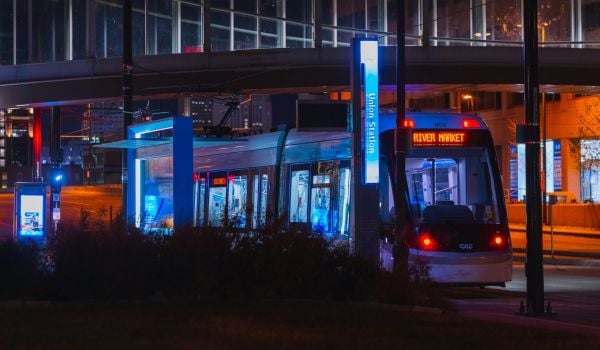For youth interested in transit, delving into the field has long meant knowing someone who worked inside.
That’s how Austin Lee set his sights on becoming a San Francisco Muni mechanic. Lee – who this fall will begin his second year studying to be an auto mechanic at Skyline College, a community college five miles south of San Francisco’s southern border – began riding Muni by himself since freshman year of high school. And although he spent time making videos of Muni buses and bus models on Minecraft, it wasn’t until he met a mechanic during a solitary visit to a Muni bus garage in 2018 that he learned more about being a mechanic and working for Muni.
“I noticed that some buses would occasionally break down, causing delays and rage among passengers,” Lee says. “If I could fix buses, then passengers would not complain about any breakdowns. This could also help my family members get to places. The city would have a much more reliable transit system than it was before.”
San Francisco Muni has long struggled, particularly with engaging youth, who made up 5% of all boardings in 2019, according to Clipper data obtained from the Bay Area Metropolitan Transportation Commission.

SFMTA’s Youth Transportation Advisory Board engages San Francisco youth in shaping their city's transit system. (Photo courtesy of SFMTA)
In the past, Muni generally engaged youth through community organizations or the city’s Youth Commission, although some of their staff have done so on their own volition. The agency also has a number of workforce development programs.
But the agency is among many who are beginning to create intentional spaces for youth to recognize their experiences navigating transit. To ensure young transit riders felt safe sharing about their experiences using Muni and what needed to be improved, they created the Youth Transportation Advisory Board, which is composed of youth ages 14 to 19 who live or go to school in San Francisco, rather than dedicating seats on their existing Citizens Advisory Committee, composed of adults and senior citizens, so they feel safe sharing their feedback.
“Young people’s reliance on the transportation system and experience navigating it make them transportation experts,” said the SFMTA’s Youth Transportation Advisory Board Team in a statement. “By amplifying the perspectives of local youth, the SFMTA is investing in the next generation of transit riders, whose experiences can and should shape the development of the transportation system.”
Engaging youth is part of a broader initiative at the agency to address racial equity, itself a part of a citywide initiative to address systemic racism. The agency is not sure how much running the program will cost. Members are compensated with gift cards, and can also be mentored by members of the agency’s board.
Since convening the YTAB, the agency has learned their existing safety and security measures are inadequate to keep girls, nonbinary and queer youth safe from harassment. They also learned youth do not want to interact with the agency’s social media accounts, found it challenging to navigate the system, and believe they are discriminated against by bus drivers.
Across the Bay, San Francisco Bay Area Rapid Transit District, where youth comprise 2% of system ridership, made similar findings. “They know what they want out of our system, [it’s] just no one’s listening to them, or they’re looked at as like a gadfly,” says BART’s Chief Communications Officer Alicia Trost. “They all ride our system and … one day, when they get 9-to-whatever types of full-time jobs, they may rely on us, or may even decide not to own a car and they only want transit. But we’re not building enough connections with youth right now to inspire that from them.”
To better engage youth, both agencies started TikTok accounts; BART’s TikTok account has over 18,000 followers, second only to the New York City Transportation Authority. “You got to reach them where they’re at,” said Melody Starling, who is consulting with BART on ways to engage youth after serving on Southeastern Pennsylvania Transportation Authority’s youth advisory board. “The pandemic has changed how we need to engage with young people; [they’re] in a world where everything is more remote.”
In other regions, too, transit agencies have worked to engage young riders and potential riders. For almost a decade, the Orange County Transportation Authority convened youth to solicit feedback about their transportation programs while also discussing the county’s transportation system while developing their leadership skills. In 2019, the Seattle Department of Transportation piloted its Youth Transportation Ambassadors Program, collaborating with community-based organizations to educate young leaders about public transit options and help shape discussions about transit access, education and safety.
Two years later, King County Metro, which serves Seattle, began working with the Youth for Equitable Streets coalition on a student-led research project about how South King County’s Black, Indigenous, and other youth of color use transit. As a result of the research, King County Metro removed fees for ORCA Youth cards and increased youth fare subsidies.
Although BART hasn’t convened a formal committee of youth to engage with over the service they provide, in April they invited a group of Bay Area-based youth to their headquarters to have a conversation with their general manager. The group calls itself the Transit Twitter Besties because they gather on Twitter to talk about transit and venture on transit joyrides.
Trost first learned of them when they were tagged on Twitter posts containing maps produced by Fern Hahn, a Bay Area native who is a part of the group and uses they/them pronouns. Hahn channeled their lifelong love for transit, influenced by their mother’s work as an urban planner as well as through their move to Berkeley, California as a young teen, into creating transit maps emphasizing lines, connections, topologies and frequencies, rather than mode.
“The whole time, my love for transport has been coupled with a fascination with maps,” said Hahn over Twitter direct messages. “I like to see how information can be compactly arranged and presented in a way that’s legible, easy to follow, and attractive, as in a transit map or on a station sign. I think ultimately, I’m most interested in the system that is a public transit network — the lines, connections, topologies, frequencies — rather than in any individual mode, technology, or vehicle.”
Now, Hahn plans to hone their interest in wayfinding when they begin studying urban planning at the Toronto Metropolitan University in the fall.
Both agencies have also begun taking aim at eliminating sexual harassment on transit. Both BART and Muni allow riders to report sexual harassment without calling 911 – Muni through the city’s 311 hotline, and BART through their BART Watch crime reporting app. BART, through their engaging youth around developing a sexual harassment awareness campaign, also hired youth to serve on hiring panels for transit ambassadors and crisis intervention specialists to ensure they can foster a safe riding environment for all.
Meanwhile, Muni plans to conduct more engagement to understand how to make transit safe for femme riders. The California State Assembly will also consider a bill already passed by the state senate to require the top 10 highest ridership agencies, which include BART and Muni, to understand why people do not feel safe riding transit, and to make it safer for them to do so.
Applications for San Francisco Muni’s Youth Transit Advisory Board open Aug. 1. Applications for OCTA’s Teen Council are due July 31.
This story has been updated to correct Hahn’s plans for university.

H. Jiahong Pan 潘嘉宏 (pronouns: they/them/佢/他) is a Minneapolis-based introverted freelance journalist who reports primarily on their lifelong passion: transportation issues. Find them on a bus of all types, the sidewalk, bike lane, hiking trail or perhaps the occasional carshare vehicle, camera and perhaps watercolor set or mushroom brush in tow, in your community or state or regional park regardless of season. If you can’t find them, they’re probably cooking, writing, curating an archive of wall art or brochures, playing board games, sewing or cuddling with their cat.
















